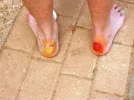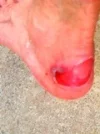D
Deleted member 397
Guest
A cintentious topic. This post is aimed at those who are undeciced whetherb to take them or not. the following is based on observation and comments received whilst walking from Le pUy to Santiago-about 1500 kms. The first trio I met were a group of Swiss ladies on day 3. during a break I asked the one with poles how she found them .She tossed them aside and said 'in my country they are just fashion' and said thay they served no useful purpose. A few days later I met a bloke who was a pilates teacher and taught bio mechanics in germany. He was not using poles and when I asked why he said that for this walk 'they are useless' and said that it was far more important to concentrate on the way you walked. I also saw many many walking on bitumen dutifully tap tapping away with their poles-to what purpose? I especially remember a group of 3 germans striding 3 abreast on a level bitumen road making an alarming noise with their 6 poles-frankly they looked ridiculous. Next was a French navy diver into extreme sports who also di not use them and he explained that they are intended for cross country skiing and unless you adopt the appropriate posture of bent kness, leaning forward and bent arms they serve no purpose.several have stated that they reduce knee pressure by 25%-where's the proof and is it a coincidence that it's always 25% and not 20% or 30%? It is also said that to get this benefit they need to be used 'properly' yet none of those I asked over 1500 kms knew what this meant. I assumed that the manufacturers would, as a matter of course, explain this but NONE had any information about using them 'correctly'-possibly because they are a complete waste of time.As for assisting in descents I saw 3 people have them arms wrenched back by getting these toys stuck in rocks. Another fellow had just bought a pair and said he did not know how to use them but 'thought they would be good' several hours later I saw hime walking like a Regency gentleman walking down the strand moving each arm in a semicircle-relieving pressutre off his knees?-of course not.Others have suggested they are good for fending off dogs. In 1500 kms I was menaced by 1 dog who just barked but did not approach me. Think about it-on any given day of the camino frances there would be up to 300 pilgrims passing a particular spot so it would be a very energetic dog that would bark at 300 people every day every week every year. I could give more examples but, as I said, this is aimed at those who are undecided about whether to take them.





















